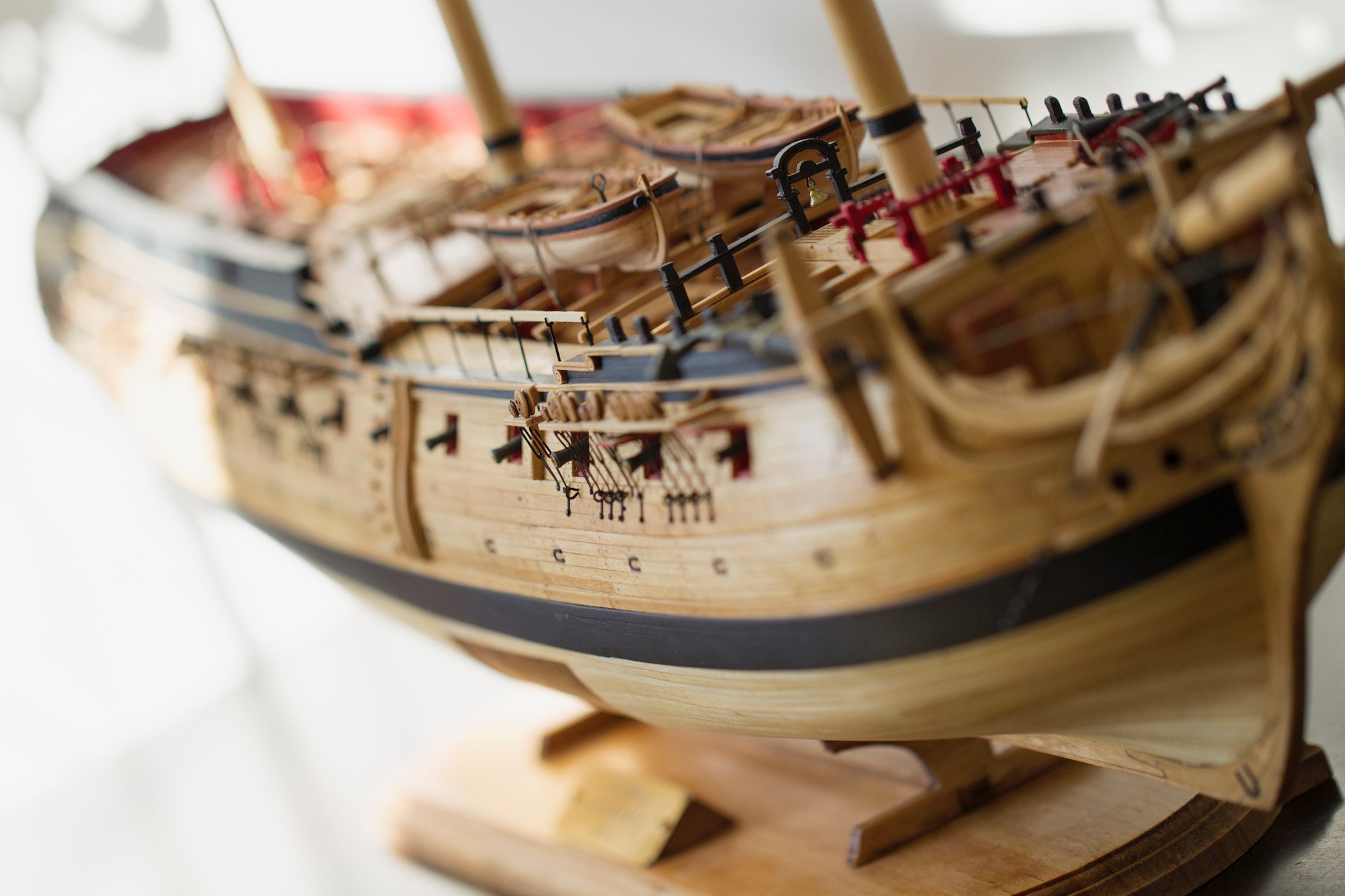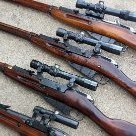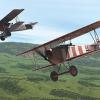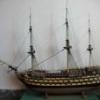-
Posts
1,028 -
Joined
-
Last visited
Reputation Activity
-
 Moonbug got a reaction from Freebird in HMS Pegasus 1776 by Moonbug - Amati Models - 1:64
Moonbug got a reaction from Freebird in HMS Pegasus 1776 by Moonbug - Amati Models - 1:64
The yard lifts are pretty simple affairs. Although the weight of the yards is endured by the large rope and blocks of the jeers, the much more lightweight lifts are used to square the yards perpendicular to the masts. The yard lifts for both the fore and main yards are 3" lines (.35mm at scale) that originate at 9" (3.5mm) blocks secured with hooks to the eyebolts at the fore of each mast cap. The lines run from this block, down through the lift block on the end of the yard arm (attached to the sheet block), back up through the block at the mast cap, then down through the lubbers' hole to secure on either a timberhead or rail.
The fore yard lifts are secured on a forecastle timberhead next to the mast & swivel gun. The main yard lifts are secured on the quarterdeck rail.
-
 Moonbug got a reaction from Desertanimal in HMS Pegasus 1776 by Moonbug - Amati Models - 1:64
Moonbug got a reaction from Desertanimal in HMS Pegasus 1776 by Moonbug - Amati Models - 1:64
The yard lifts are pretty simple affairs. Although the weight of the yards is endured by the large rope and blocks of the jeers, the much more lightweight lifts are used to square the yards perpendicular to the masts. The yard lifts for both the fore and main yards are 3" lines (.35mm at scale) that originate at 9" (3.5mm) blocks secured with hooks to the eyebolts at the fore of each mast cap. The lines run from this block, down through the lift block on the end of the yard arm (attached to the sheet block), back up through the block at the mast cap, then down through the lubbers' hole to secure on either a timberhead or rail.
The fore yard lifts are secured on a forecastle timberhead next to the mast & swivel gun. The main yard lifts are secured on the quarterdeck rail.
-
 Moonbug got a reaction from Freebird in HMS Pegasus 1776 by Moonbug - Amati Models - 1:64
Moonbug got a reaction from Freebird in HMS Pegasus 1776 by Moonbug - Amati Models - 1:64
As is well documented - rigging both the main and fore lower yards is essentially the same process and starts with the truss pendants and tackles. The truss pendants partially attach the yard, but their primary role is to prevent the yards from pulling away from the mast in the forward direction. There is a pair of pendants on each yard that run down each side of the mast. They start with a stropping a thimble to each pendant and wrapping it just inside the cleat against the quarter block. I realize I opted to forgo some thimbles at this scale, but these are too important to accuracy (and functionality) to settle for eyelets. The thimbles are as I've done in the past - using brass tubing cut, then sanded down to size. Start by stropping the thimble using 4" (.50mm at scale) line. I used CA glue to hold the line in place around the thimble and tied a half knot with 120 thread leaving a long tail. Then I wrapped the line around the mast and seize it back onto itself using that tail of thread.
Each line is then passed around the mast and through the thimble of its mate. I did this very loosely , then I temporarily fed the Jeer line through the jeer blocks and fastened the lines to the mast with a clip to hold the yard in place. Essentially, rigging the truss pendants and jeer tackles were done in tandem as that was the only way for me to hold the yard in place while I worked.
The truss pendant falls end with 8" (3.5mm at scale) double blocks. Those blocks make up the truss pendant tackle along with another 8" double block that is stropped to a hook attached to one of the eye bolts at the base of the mast. To rig this tackle I started by measuring the length of the tackle which should be a 2" rope (.25mm) with a length of about 24' or 115mm at scale. Obviously I gave myself a little extra wiggle room. I rigged the double blocks on both sides first, giving me the ability to adjust the tension of each side as needed after I hook them in place.
Adjusting the tension of each truss pendant tackle allows you to straighten the yard. After adjusting, the fall is secured with several turns around itself and held with a half hitch.
Now I can turn my attention back to the jeer tyes and tackle. The jeer tyres are pretty hefty lines at 7" - or .89mm at scale and also end with a double block - this one being 12" or about 5mm at scale. I started by measuring the approximate length of the line, which for me was about 280mm, attaching one double block to an end. The line feeds up through one jeer block on the mast, down through the jeer block in the center of the yard, back up through the second mast jeer block, then down again to another double block - the whole thing looks like a nice "M".
Make sure the yard is the proper height - for me it was just below the uppermost woolding wrap - then measure the distance of the second fall as equal to the first and attach the second double block. It actually took me a little bit to noodle out the tackle at the jeer tye falls. There were some sources, including the FFM, that indicate that it replicates the truss fall pendants with two double blocks at the bottom of the tackle. However, looking at the images and diagrams from the FFM - only one of the sheaves in the bottom double block ends up being used. So I went with a 4.5mm single block on the bottom tackle which allows for the line to be secured through the sheave on the jeer bitts and belay around the rail. This is the same method that Dan Vadas shows in his Vulture Build.
And yes - for those of you wondering - I did notice my early blackening job on the eyebolts flaking terribly, so I've since redone / touched those eyebolts up. As mentioned, the main yard is nearly an identical process to the fore yard. That said, I chose to use slightly larger (6.5mm) double blocks for the jeers. I just felt they balanced better with the large .89mm line used.
Also, similar to the fore yard, the FFM calls for these lines to run through the jeer bitts at the base of the mast, just aft of the bilge pumps. I couldn't make this happen without the lines fouling, so I opted to run them through the sheaves on the railing and then belay them to the railing. Notice also that I needed to remove the hand pumps to gain access to the eyebolts and other areas at the base of the mast.
As with the truss pendants, the jeer tackles are adjusted to even out the falls. Then all of the lines are wrapped and held in place with a touch of ca glue until I finalize everything later with rope coils.
-
 Moonbug got a reaction from KARAVOKIRIS in HMS Pegasus 1776 by Moonbug - Amati Models - 1:64
Moonbug got a reaction from KARAVOKIRIS in HMS Pegasus 1776 by Moonbug - Amati Models - 1:64
The yard lifts are pretty simple affairs. Although the weight of the yards is endured by the large rope and blocks of the jeers, the much more lightweight lifts are used to square the yards perpendicular to the masts. The yard lifts for both the fore and main yards are 3" lines (.35mm at scale) that originate at 9" (3.5mm) blocks secured with hooks to the eyebolts at the fore of each mast cap. The lines run from this block, down through the lift block on the end of the yard arm (attached to the sheet block), back up through the block at the mast cap, then down through the lubbers' hole to secure on either a timberhead or rail.
The fore yard lifts are secured on a forecastle timberhead next to the mast & swivel gun. The main yard lifts are secured on the quarterdeck rail.
-
 Moonbug got a reaction from Desertanimal in HMS Pegasus 1776 by Moonbug - Amati Models - 1:64
Moonbug got a reaction from Desertanimal in HMS Pegasus 1776 by Moonbug - Amati Models - 1:64
As is well documented - rigging both the main and fore lower yards is essentially the same process and starts with the truss pendants and tackles. The truss pendants partially attach the yard, but their primary role is to prevent the yards from pulling away from the mast in the forward direction. There is a pair of pendants on each yard that run down each side of the mast. They start with a stropping a thimble to each pendant and wrapping it just inside the cleat against the quarter block. I realize I opted to forgo some thimbles at this scale, but these are too important to accuracy (and functionality) to settle for eyelets. The thimbles are as I've done in the past - using brass tubing cut, then sanded down to size. Start by stropping the thimble using 4" (.50mm at scale) line. I used CA glue to hold the line in place around the thimble and tied a half knot with 120 thread leaving a long tail. Then I wrapped the line around the mast and seize it back onto itself using that tail of thread.
Each line is then passed around the mast and through the thimble of its mate. I did this very loosely , then I temporarily fed the Jeer line through the jeer blocks and fastened the lines to the mast with a clip to hold the yard in place. Essentially, rigging the truss pendants and jeer tackles were done in tandem as that was the only way for me to hold the yard in place while I worked.
The truss pendant falls end with 8" (3.5mm at scale) double blocks. Those blocks make up the truss pendant tackle along with another 8" double block that is stropped to a hook attached to one of the eye bolts at the base of the mast. To rig this tackle I started by measuring the length of the tackle which should be a 2" rope (.25mm) with a length of about 24' or 115mm at scale. Obviously I gave myself a little extra wiggle room. I rigged the double blocks on both sides first, giving me the ability to adjust the tension of each side as needed after I hook them in place.
Adjusting the tension of each truss pendant tackle allows you to straighten the yard. After adjusting, the fall is secured with several turns around itself and held with a half hitch.
Now I can turn my attention back to the jeer tyes and tackle. The jeer tyres are pretty hefty lines at 7" - or .89mm at scale and also end with a double block - this one being 12" or about 5mm at scale. I started by measuring the approximate length of the line, which for me was about 280mm, attaching one double block to an end. The line feeds up through one jeer block on the mast, down through the jeer block in the center of the yard, back up through the second mast jeer block, then down again to another double block - the whole thing looks like a nice "M".
Make sure the yard is the proper height - for me it was just below the uppermost woolding wrap - then measure the distance of the second fall as equal to the first and attach the second double block. It actually took me a little bit to noodle out the tackle at the jeer tye falls. There were some sources, including the FFM, that indicate that it replicates the truss fall pendants with two double blocks at the bottom of the tackle. However, looking at the images and diagrams from the FFM - only one of the sheaves in the bottom double block ends up being used. So I went with a 4.5mm single block on the bottom tackle which allows for the line to be secured through the sheave on the jeer bitts and belay around the rail. This is the same method that Dan Vadas shows in his Vulture Build.
And yes - for those of you wondering - I did notice my early blackening job on the eyebolts flaking terribly, so I've since redone / touched those eyebolts up. As mentioned, the main yard is nearly an identical process to the fore yard. That said, I chose to use slightly larger (6.5mm) double blocks for the jeers. I just felt they balanced better with the large .89mm line used.
Also, similar to the fore yard, the FFM calls for these lines to run through the jeer bitts at the base of the mast, just aft of the bilge pumps. I couldn't make this happen without the lines fouling, so I opted to run them through the sheaves on the railing and then belay them to the railing. Notice also that I needed to remove the hand pumps to gain access to the eyebolts and other areas at the base of the mast.
As with the truss pendants, the jeer tackles are adjusted to even out the falls. Then all of the lines are wrapped and held in place with a touch of ca glue until I finalize everything later with rope coils.
-
 Moonbug reacted to Yabuhebi in HMS Victory by Yabuhebi (Chris) - Caldercraft - 1:72
Moonbug reacted to Yabuhebi in HMS Victory by Yabuhebi (Chris) - Caldercraft - 1:72
Since I had painted the lower deadeyes as part of assembling the chainplate platforms I had to paint the partner deadeyes.
I don't have enough pins and I'm not really sure if I wanted to pin 30+ large deadeyes and a multitude of the small ones. I also did not want to paint them with a brush because it would absolutely clog the holes. Air brushing at least is clean.
I tried stringing all the like deadeyes together on wire and painting them. It was a 70% success on the larger one, haven't looked at the smaller ones yet.
I will have to touch up some with a brush and then go over them to make sure they stay clog free.
-
 Moonbug got a reaction from AJohnson in HMS Pegasus 1776 by Moonbug - Amati Models - 1:64
Moonbug got a reaction from AJohnson in HMS Pegasus 1776 by Moonbug - Amati Models - 1:64
Thanks Bob, always appreciate the kind words. I enjoy the photography part as well; I have a little background in that area so it’s nice to still be able to use the tools.
Looking forward to when you get your Peg back in the bench.
-
 Moonbug reacted to Knocklouder in Duchess of Kingston 1778 by Knocklouder - FINISHED - Vanguard Models - 1/64 - Royal Yacht
Moonbug reacted to Knocklouder in Duchess of Kingston 1778 by Knocklouder - FINISHED - Vanguard Models - 1/64 - Royal Yacht
Well @Gabekmaybe not lol. I stared a swear jar for the Sea of Galilee Boat that I did awhile ago, 25 cents a word. In the past week I all most have enough for a Surprise. Dang, as they Texas lol.
Today I got to thank @John Ruy for telling me about this rigging tool. I have one from the Hannah-SIB that I did as well. Completely forgot about it. I starting using it today and things went alot better. Way way better Thanks.
lines still get crossed. Belaying is a Neanderthals night mare . Running all the lines for the Bowsprit mast and the foremast.we have them all tied on . Not glued because they may be adjustment later.
Man I can't afford to break the Bowsprit mast any more, now that I have finished rigging it lol. Pile grabed a quick nap, but woke up screaming he was having a nightmare about me breaking the Bowsprit AGAIN lol
Moving on to the mian mast then Mizzen
mast.couple of days lol. Then the anchors and stand leaving only the optional ships boat lol
Rigging is insanely fun frustrating work, but I am doing it lol. Thank you for stopping by and peeking in.
I am grinning now. Pretty sure of what's left, but there is always surprises 😮.
Knocklouder
-
 Moonbug reacted to Knocklouder in HMS Pegasus 1776 by Moonbug - Amati Models - 1:64
Moonbug reacted to Knocklouder in HMS Pegasus 1776 by Moonbug - Amati Models - 1:64
Great work Bug . You keep taking those wonderful pictures of your Pegasus. When I finally get back to mine I will have this wonderful log to use to rig my Pegasus. Thanks so much for your log.
Bob M.
-
 Moonbug got a reaction from RossR in HMS Pegasus 1776 by Moonbug - Amati Models - 1:64
Moonbug got a reaction from RossR in HMS Pegasus 1776 by Moonbug - Amati Models - 1:64
Hey @RossR - Thanks for the kind words - much appreciated.
Sort of card stock - after trying a few things for the hoops, I settled on slicing a Manila file folder into strips with a razor. It had just the right thickness for my scale.
-
 Moonbug got a reaction from KARAVOKIRIS in HMS Pegasus 1776 by Moonbug - Amati Models - 1:64
Moonbug got a reaction from KARAVOKIRIS in HMS Pegasus 1776 by Moonbug - Amati Models - 1:64
As is well documented - rigging both the main and fore lower yards is essentially the same process and starts with the truss pendants and tackles. The truss pendants partially attach the yard, but their primary role is to prevent the yards from pulling away from the mast in the forward direction. There is a pair of pendants on each yard that run down each side of the mast. They start with a stropping a thimble to each pendant and wrapping it just inside the cleat against the quarter block. I realize I opted to forgo some thimbles at this scale, but these are too important to accuracy (and functionality) to settle for eyelets. The thimbles are as I've done in the past - using brass tubing cut, then sanded down to size. Start by stropping the thimble using 4" (.50mm at scale) line. I used CA glue to hold the line in place around the thimble and tied a half knot with 120 thread leaving a long tail. Then I wrapped the line around the mast and seize it back onto itself using that tail of thread.
Each line is then passed around the mast and through the thimble of its mate. I did this very loosely , then I temporarily fed the Jeer line through the jeer blocks and fastened the lines to the mast with a clip to hold the yard in place. Essentially, rigging the truss pendants and jeer tackles were done in tandem as that was the only way for me to hold the yard in place while I worked.
The truss pendant falls end with 8" (3.5mm at scale) double blocks. Those blocks make up the truss pendant tackle along with another 8" double block that is stropped to a hook attached to one of the eye bolts at the base of the mast. To rig this tackle I started by measuring the length of the tackle which should be a 2" rope (.25mm) with a length of about 24' or 115mm at scale. Obviously I gave myself a little extra wiggle room. I rigged the double blocks on both sides first, giving me the ability to adjust the tension of each side as needed after I hook them in place.
Adjusting the tension of each truss pendant tackle allows you to straighten the yard. After adjusting, the fall is secured with several turns around itself and held with a half hitch.
Now I can turn my attention back to the jeer tyes and tackle. The jeer tyres are pretty hefty lines at 7" - or .89mm at scale and also end with a double block - this one being 12" or about 5mm at scale. I started by measuring the approximate length of the line, which for me was about 280mm, attaching one double block to an end. The line feeds up through one jeer block on the mast, down through the jeer block in the center of the yard, back up through the second mast jeer block, then down again to another double block - the whole thing looks like a nice "M".
Make sure the yard is the proper height - for me it was just below the uppermost woolding wrap - then measure the distance of the second fall as equal to the first and attach the second double block. It actually took me a little bit to noodle out the tackle at the jeer tye falls. There were some sources, including the FFM, that indicate that it replicates the truss fall pendants with two double blocks at the bottom of the tackle. However, looking at the images and diagrams from the FFM - only one of the sheaves in the bottom double block ends up being used. So I went with a 4.5mm single block on the bottom tackle which allows for the line to be secured through the sheave on the jeer bitts and belay around the rail. This is the same method that Dan Vadas shows in his Vulture Build.
And yes - for those of you wondering - I did notice my early blackening job on the eyebolts flaking terribly, so I've since redone / touched those eyebolts up. As mentioned, the main yard is nearly an identical process to the fore yard. That said, I chose to use slightly larger (6.5mm) double blocks for the jeers. I just felt they balanced better with the large .89mm line used.
Also, similar to the fore yard, the FFM calls for these lines to run through the jeer bitts at the base of the mast, just aft of the bilge pumps. I couldn't make this happen without the lines fouling, so I opted to run them through the sheaves on the railing and then belay them to the railing. Notice also that I needed to remove the hand pumps to gain access to the eyebolts and other areas at the base of the mast.
As with the truss pendants, the jeer tackles are adjusted to even out the falls. Then all of the lines are wrapped and held in place with a touch of ca glue until I finalize everything later with rope coils.
-
 Moonbug got a reaction from Barbossa in HMS Pegasus 1776 by Moonbug - Amati Models - 1:64
Moonbug got a reaction from Barbossa in HMS Pegasus 1776 by Moonbug - Amati Models - 1:64
The yard lifts are pretty simple affairs. Although the weight of the yards is endured by the large rope and blocks of the jeers, the much more lightweight lifts are used to square the yards perpendicular to the masts. The yard lifts for both the fore and main yards are 3" lines (.35mm at scale) that originate at 9" (3.5mm) blocks secured with hooks to the eyebolts at the fore of each mast cap. The lines run from this block, down through the lift block on the end of the yard arm (attached to the sheet block), back up through the block at the mast cap, then down through the lubbers' hole to secure on either a timberhead or rail.
The fore yard lifts are secured on a forecastle timberhead next to the mast & swivel gun. The main yard lifts are secured on the quarterdeck rail.
-
 Moonbug got a reaction from brunnels in HMS Pegasus 1776 by Moonbug - Amati Models - 1:64
Moonbug got a reaction from brunnels in HMS Pegasus 1776 by Moonbug - Amati Models - 1:64
The yard lifts are pretty simple affairs. Although the weight of the yards is endured by the large rope and blocks of the jeers, the much more lightweight lifts are used to square the yards perpendicular to the masts. The yard lifts for both the fore and main yards are 3" lines (.35mm at scale) that originate at 9" (3.5mm) blocks secured with hooks to the eyebolts at the fore of each mast cap. The lines run from this block, down through the lift block on the end of the yard arm (attached to the sheet block), back up through the block at the mast cap, then down through the lubbers' hole to secure on either a timberhead or rail.
The fore yard lifts are secured on a forecastle timberhead next to the mast & swivel gun. The main yard lifts are secured on the quarterdeck rail.
-
 Moonbug got a reaction from AJohnson in HMS Pegasus 1776 by Moonbug - Amati Models - 1:64
Moonbug got a reaction from AJohnson in HMS Pegasus 1776 by Moonbug - Amati Models - 1:64
Hey @RossR - Thanks for the kind words - much appreciated.
Sort of card stock - after trying a few things for the hoops, I settled on slicing a Manila file folder into strips with a razor. It had just the right thickness for my scale.
-
 Moonbug got a reaction from Scott Crouse in HMS Pegasus 1776 by Moonbug - Amati Models - 1:64
Moonbug got a reaction from Scott Crouse in HMS Pegasus 1776 by Moonbug - Amati Models - 1:64
The yard lifts are pretty simple affairs. Although the weight of the yards is endured by the large rope and blocks of the jeers, the much more lightweight lifts are used to square the yards perpendicular to the masts. The yard lifts for both the fore and main yards are 3" lines (.35mm at scale) that originate at 9" (3.5mm) blocks secured with hooks to the eyebolts at the fore of each mast cap. The lines run from this block, down through the lift block on the end of the yard arm (attached to the sheet block), back up through the block at the mast cap, then down through the lubbers' hole to secure on either a timberhead or rail.
The fore yard lifts are secured on a forecastle timberhead next to the mast & swivel gun. The main yard lifts are secured on the quarterdeck rail.
-
 Moonbug got a reaction from brunnels in HMS Pegasus 1776 by Moonbug - Amati Models - 1:64
Moonbug got a reaction from brunnels in HMS Pegasus 1776 by Moonbug - Amati Models - 1:64
As is well documented - rigging both the main and fore lower yards is essentially the same process and starts with the truss pendants and tackles. The truss pendants partially attach the yard, but their primary role is to prevent the yards from pulling away from the mast in the forward direction. There is a pair of pendants on each yard that run down each side of the mast. They start with a stropping a thimble to each pendant and wrapping it just inside the cleat against the quarter block. I realize I opted to forgo some thimbles at this scale, but these are too important to accuracy (and functionality) to settle for eyelets. The thimbles are as I've done in the past - using brass tubing cut, then sanded down to size. Start by stropping the thimble using 4" (.50mm at scale) line. I used CA glue to hold the line in place around the thimble and tied a half knot with 120 thread leaving a long tail. Then I wrapped the line around the mast and seize it back onto itself using that tail of thread.
Each line is then passed around the mast and through the thimble of its mate. I did this very loosely , then I temporarily fed the Jeer line through the jeer blocks and fastened the lines to the mast with a clip to hold the yard in place. Essentially, rigging the truss pendants and jeer tackles were done in tandem as that was the only way for me to hold the yard in place while I worked.
The truss pendant falls end with 8" (3.5mm at scale) double blocks. Those blocks make up the truss pendant tackle along with another 8" double block that is stropped to a hook attached to one of the eye bolts at the base of the mast. To rig this tackle I started by measuring the length of the tackle which should be a 2" rope (.25mm) with a length of about 24' or 115mm at scale. Obviously I gave myself a little extra wiggle room. I rigged the double blocks on both sides first, giving me the ability to adjust the tension of each side as needed after I hook them in place.
Adjusting the tension of each truss pendant tackle allows you to straighten the yard. After adjusting, the fall is secured with several turns around itself and held with a half hitch.
Now I can turn my attention back to the jeer tyes and tackle. The jeer tyres are pretty hefty lines at 7" - or .89mm at scale and also end with a double block - this one being 12" or about 5mm at scale. I started by measuring the approximate length of the line, which for me was about 280mm, attaching one double block to an end. The line feeds up through one jeer block on the mast, down through the jeer block in the center of the yard, back up through the second mast jeer block, then down again to another double block - the whole thing looks like a nice "M".
Make sure the yard is the proper height - for me it was just below the uppermost woolding wrap - then measure the distance of the second fall as equal to the first and attach the second double block. It actually took me a little bit to noodle out the tackle at the jeer tye falls. There were some sources, including the FFM, that indicate that it replicates the truss fall pendants with two double blocks at the bottom of the tackle. However, looking at the images and diagrams from the FFM - only one of the sheaves in the bottom double block ends up being used. So I went with a 4.5mm single block on the bottom tackle which allows for the line to be secured through the sheave on the jeer bitts and belay around the rail. This is the same method that Dan Vadas shows in his Vulture Build.
And yes - for those of you wondering - I did notice my early blackening job on the eyebolts flaking terribly, so I've since redone / touched those eyebolts up. As mentioned, the main yard is nearly an identical process to the fore yard. That said, I chose to use slightly larger (6.5mm) double blocks for the jeers. I just felt they balanced better with the large .89mm line used.
Also, similar to the fore yard, the FFM calls for these lines to run through the jeer bitts at the base of the mast, just aft of the bilge pumps. I couldn't make this happen without the lines fouling, so I opted to run them through the sheaves on the railing and then belay them to the railing. Notice also that I needed to remove the hand pumps to gain access to the eyebolts and other areas at the base of the mast.
As with the truss pendants, the jeer tackles are adjusted to even out the falls. Then all of the lines are wrapped and held in place with a touch of ca glue until I finalize everything later with rope coils.
-
 Moonbug got a reaction from vossiewulf in HMS Pegasus 1776 by Moonbug - Amati Models - 1:64
Moonbug got a reaction from vossiewulf in HMS Pegasus 1776 by Moonbug - Amati Models - 1:64
The yard lifts are pretty simple affairs. Although the weight of the yards is endured by the large rope and blocks of the jeers, the much more lightweight lifts are used to square the yards perpendicular to the masts. The yard lifts for both the fore and main yards are 3" lines (.35mm at scale) that originate at 9" (3.5mm) blocks secured with hooks to the eyebolts at the fore of each mast cap. The lines run from this block, down through the lift block on the end of the yard arm (attached to the sheet block), back up through the block at the mast cap, then down through the lubbers' hole to secure on either a timberhead or rail.
The fore yard lifts are secured on a forecastle timberhead next to the mast & swivel gun. The main yard lifts are secured on the quarterdeck rail.
-
 Moonbug reacted to RossR in HMS Pegasus 1776 by Moonbug - Amati Models - 1:64
Moonbug reacted to RossR in HMS Pegasus 1776 by Moonbug - Amati Models - 1:64
Great work. Your rigging is so neat and clean. I hope to come close to what you are producing someday.
I like the detail of the wood bands above and below the woldings. This is a detail you don't see added too often, Sorry if you mentioned this in an earlier post, but did you use card stock for that?
-
 Moonbug got a reaction from Auger in HMS Pegasus 1776 by Moonbug - Amati Models - 1:64
Moonbug got a reaction from Auger in HMS Pegasus 1776 by Moonbug - Amati Models - 1:64
The yard lifts are pretty simple affairs. Although the weight of the yards is endured by the large rope and blocks of the jeers, the much more lightweight lifts are used to square the yards perpendicular to the masts. The yard lifts for both the fore and main yards are 3" lines (.35mm at scale) that originate at 9" (3.5mm) blocks secured with hooks to the eyebolts at the fore of each mast cap. The lines run from this block, down through the lift block on the end of the yard arm (attached to the sheet block), back up through the block at the mast cap, then down through the lubbers' hole to secure on either a timberhead or rail.
The fore yard lifts are secured on a forecastle timberhead next to the mast & swivel gun. The main yard lifts are secured on the quarterdeck rail.
-
 Moonbug got a reaction from AJohnson in HMS Pegasus 1776 by Moonbug - Amati Models - 1:64
Moonbug got a reaction from AJohnson in HMS Pegasus 1776 by Moonbug - Amati Models - 1:64
The yard lifts are pretty simple affairs. Although the weight of the yards is endured by the large rope and blocks of the jeers, the much more lightweight lifts are used to square the yards perpendicular to the masts. The yard lifts for both the fore and main yards are 3" lines (.35mm at scale) that originate at 9" (3.5mm) blocks secured with hooks to the eyebolts at the fore of each mast cap. The lines run from this block, down through the lift block on the end of the yard arm (attached to the sheet block), back up through the block at the mast cap, then down through the lubbers' hole to secure on either a timberhead or rail.
The fore yard lifts are secured on a forecastle timberhead next to the mast & swivel gun. The main yard lifts are secured on the quarterdeck rail.
-
 Moonbug got a reaction from Barbossa in HMS Pegasus 1776 by Moonbug - Amati Models - 1:64
Moonbug got a reaction from Barbossa in HMS Pegasus 1776 by Moonbug - Amati Models - 1:64
Adding all of the accouterments to the lower yards is another classic example of "not very many photos for quite a bit of work." It's well documented in a number of places, but the fore and main lower yards are the same and are both affixed with the following blocks according to the FFM.
Jeer Block - 1 x 20" (8 mm) single block double stropped
Quarter Blocks - 2 x 14" (5.5mm) single
Clueline Blocks - 2 x 9" (3.5mm) single
Tricing Line Blocks - 4 x 6" (2.5mm) single
Buntline Blocks - 4 x 8" (3mm) single
Leechline Blocks - 2 x 7" (2.8 - I went with 3mm) single
Yard Tackle Blocks - 2 x 15" (6mm) Violin blocks
Brace Blocks - 2 x 8" (3mm) single
Topsail Sheet Blocks & Lift blocks - 2 x 12" (4.5mm) Shoulder blocks with 2 x 9" (3.5mm) seized to them
I'll note here that I did permit myself a couple of "shortcuts" as I did with the spritsail - in that I did not use served line for the inner blocks only the yard tackles and brace pendants. As I both read and discovered on my own, order ends up being pretty important here. I started in the middle with the Jeer, quarter, and inside clueline blocks. I'll also say that getting the ties and knots clean at this scale is a little challenging as well. The Jeers are .50mm line, the quarters are .40mm line and the inside cluelines are .30mm. As show the quarter blocks are snug inside the cleats and the cluelines are just outside.
Next up for me were the smaller inside and outside tricing lines, for which I used .15mm line. I did these next so that they would give me a good frame of reference in terms of distance. Buntline blocks were up next using .25mm line - same for the leechline blocks. As noted above, these should be slightly smaller than the buntline blocks, but to such a small degree that it wouldn't be noticeable at this scale - so I used the same size. Note that the tricing lines face aftward while the bunt and leech blocks face up.
The stirrups and horses are up next these need to be placed as they fit against the outer cleats inboard of the yards, braces, and topsail sheets. The stirrups are 3.5" (.45mm) and the horses are 2.5" (.35mm) both rigged the same as the spritsail yard with the stirrups wrapped three times around the yard and the horses seized at the ends and running through the stirrups. As with the spritsail, I did not use eyes here only seized loops. I forgot to take a picture of it - but after mounting the stirrups and horses I lathered them with diluted white glue, hung clips on them, then let them dry the same way I did with the spritsail yard.
Yard tackles are .50mm served line that end in the violin blocks. I had premade violin blocks for the fore yard, but connected and sanded to single blocks to create a violin for the main yard. Lees suggests that the Yard pendants are about 13' while the brace pendants (ending in a single block) are about 14-18'. I have to be honest here - I basically eyeballed them just making sure that the brace pendant was a bit longer.
Both pendants are seized around the yard at the end cleats with the yard tackle inboard of the brace pendant. Outboard of those are the topsail sheet block and lift block combo. The topsail is a shoulder block, which is a typical single but carefully sanded with a pin file to create this 'notch' shape. The Lift block is then seized above it.
As mentioned, the main yard is rigged the same as the fore yard. Both now ready for rigging to the Peg.
-
 Moonbug reacted to Beakerboy123 in HMS Pegasus by Beakerboy123 - Amati/Victory Models - 1:64
Moonbug reacted to Beakerboy123 in HMS Pegasus by Beakerboy123 - Amati/Victory Models - 1:64
Pegasus is in her place in my office. Love just staring at it.
-
 Moonbug got a reaction from KARAVOKIRIS in HMS Pegasus 1776 by Moonbug - Amati Models - 1:64
Moonbug got a reaction from KARAVOKIRIS in HMS Pegasus 1776 by Moonbug - Amati Models - 1:64
Adding all of the accouterments to the lower yards is another classic example of "not very many photos for quite a bit of work." It's well documented in a number of places, but the fore and main lower yards are the same and are both affixed with the following blocks according to the FFM.
Jeer Block - 1 x 20" (8 mm) single block double stropped
Quarter Blocks - 2 x 14" (5.5mm) single
Clueline Blocks - 2 x 9" (3.5mm) single
Tricing Line Blocks - 4 x 6" (2.5mm) single
Buntline Blocks - 4 x 8" (3mm) single
Leechline Blocks - 2 x 7" (2.8 - I went with 3mm) single
Yard Tackle Blocks - 2 x 15" (6mm) Violin blocks
Brace Blocks - 2 x 8" (3mm) single
Topsail Sheet Blocks & Lift blocks - 2 x 12" (4.5mm) Shoulder blocks with 2 x 9" (3.5mm) seized to them
I'll note here that I did permit myself a couple of "shortcuts" as I did with the spritsail - in that I did not use served line for the inner blocks only the yard tackles and brace pendants. As I both read and discovered on my own, order ends up being pretty important here. I started in the middle with the Jeer, quarter, and inside clueline blocks. I'll also say that getting the ties and knots clean at this scale is a little challenging as well. The Jeers are .50mm line, the quarters are .40mm line and the inside cluelines are .30mm. As show the quarter blocks are snug inside the cleats and the cluelines are just outside.
Next up for me were the smaller inside and outside tricing lines, for which I used .15mm line. I did these next so that they would give me a good frame of reference in terms of distance. Buntline blocks were up next using .25mm line - same for the leechline blocks. As noted above, these should be slightly smaller than the buntline blocks, but to such a small degree that it wouldn't be noticeable at this scale - so I used the same size. Note that the tricing lines face aftward while the bunt and leech blocks face up.
The stirrups and horses are up next these need to be placed as they fit against the outer cleats inboard of the yards, braces, and topsail sheets. The stirrups are 3.5" (.45mm) and the horses are 2.5" (.35mm) both rigged the same as the spritsail yard with the stirrups wrapped three times around the yard and the horses seized at the ends and running through the stirrups. As with the spritsail, I did not use eyes here only seized loops. I forgot to take a picture of it - but after mounting the stirrups and horses I lathered them with diluted white glue, hung clips on them, then let them dry the same way I did with the spritsail yard.
Yard tackles are .50mm served line that end in the violin blocks. I had premade violin blocks for the fore yard, but connected and sanded to single blocks to create a violin for the main yard. Lees suggests that the Yard pendants are about 13' while the brace pendants (ending in a single block) are about 14-18'. I have to be honest here - I basically eyeballed them just making sure that the brace pendant was a bit longer.
Both pendants are seized around the yard at the end cleats with the yard tackle inboard of the brace pendant. Outboard of those are the topsail sheet block and lift block combo. The topsail is a shoulder block, which is a typical single but carefully sanded with a pin file to create this 'notch' shape. The Lift block is then seized above it.
As mentioned, the main yard is rigged the same as the fore yard. Both now ready for rigging to the Peg.
-
 Moonbug got a reaction from AJohnson in HMS Pegasus 1776 by Moonbug - Amati Models - 1:64
Moonbug got a reaction from AJohnson in HMS Pegasus 1776 by Moonbug - Amati Models - 1:64
Adding all of the accouterments to the lower yards is another classic example of "not very many photos for quite a bit of work." It's well documented in a number of places, but the fore and main lower yards are the same and are both affixed with the following blocks according to the FFM.
Jeer Block - 1 x 20" (8 mm) single block double stropped
Quarter Blocks - 2 x 14" (5.5mm) single
Clueline Blocks - 2 x 9" (3.5mm) single
Tricing Line Blocks - 4 x 6" (2.5mm) single
Buntline Blocks - 4 x 8" (3mm) single
Leechline Blocks - 2 x 7" (2.8 - I went with 3mm) single
Yard Tackle Blocks - 2 x 15" (6mm) Violin blocks
Brace Blocks - 2 x 8" (3mm) single
Topsail Sheet Blocks & Lift blocks - 2 x 12" (4.5mm) Shoulder blocks with 2 x 9" (3.5mm) seized to them
I'll note here that I did permit myself a couple of "shortcuts" as I did with the spritsail - in that I did not use served line for the inner blocks only the yard tackles and brace pendants. As I both read and discovered on my own, order ends up being pretty important here. I started in the middle with the Jeer, quarter, and inside clueline blocks. I'll also say that getting the ties and knots clean at this scale is a little challenging as well. The Jeers are .50mm line, the quarters are .40mm line and the inside cluelines are .30mm. As show the quarter blocks are snug inside the cleats and the cluelines are just outside.
Next up for me were the smaller inside and outside tricing lines, for which I used .15mm line. I did these next so that they would give me a good frame of reference in terms of distance. Buntline blocks were up next using .25mm line - same for the leechline blocks. As noted above, these should be slightly smaller than the buntline blocks, but to such a small degree that it wouldn't be noticeable at this scale - so I used the same size. Note that the tricing lines face aftward while the bunt and leech blocks face up.
The stirrups and horses are up next these need to be placed as they fit against the outer cleats inboard of the yards, braces, and topsail sheets. The stirrups are 3.5" (.45mm) and the horses are 2.5" (.35mm) both rigged the same as the spritsail yard with the stirrups wrapped three times around the yard and the horses seized at the ends and running through the stirrups. As with the spritsail, I did not use eyes here only seized loops. I forgot to take a picture of it - but after mounting the stirrups and horses I lathered them with diluted white glue, hung clips on them, then let them dry the same way I did with the spritsail yard.
Yard tackles are .50mm served line that end in the violin blocks. I had premade violin blocks for the fore yard, but connected and sanded to single blocks to create a violin for the main yard. Lees suggests that the Yard pendants are about 13' while the brace pendants (ending in a single block) are about 14-18'. I have to be honest here - I basically eyeballed them just making sure that the brace pendant was a bit longer.
Both pendants are seized around the yard at the end cleats with the yard tackle inboard of the brace pendant. Outboard of those are the topsail sheet block and lift block combo. The topsail is a shoulder block, which is a typical single but carefully sanded with a pin file to create this 'notch' shape. The Lift block is then seized above it.
As mentioned, the main yard is rigged the same as the fore yard. Both now ready for rigging to the Peg.
-
 Moonbug got a reaction from gjdale in HMS Pegasus 1776 by Moonbug - Amati Models - 1:64
Moonbug got a reaction from gjdale in HMS Pegasus 1776 by Moonbug - Amati Models - 1:64
Adding all of the accouterments to the lower yards is another classic example of "not very many photos for quite a bit of work." It's well documented in a number of places, but the fore and main lower yards are the same and are both affixed with the following blocks according to the FFM.
Jeer Block - 1 x 20" (8 mm) single block double stropped
Quarter Blocks - 2 x 14" (5.5mm) single
Clueline Blocks - 2 x 9" (3.5mm) single
Tricing Line Blocks - 4 x 6" (2.5mm) single
Buntline Blocks - 4 x 8" (3mm) single
Leechline Blocks - 2 x 7" (2.8 - I went with 3mm) single
Yard Tackle Blocks - 2 x 15" (6mm) Violin blocks
Brace Blocks - 2 x 8" (3mm) single
Topsail Sheet Blocks & Lift blocks - 2 x 12" (4.5mm) Shoulder blocks with 2 x 9" (3.5mm) seized to them
I'll note here that I did permit myself a couple of "shortcuts" as I did with the spritsail - in that I did not use served line for the inner blocks only the yard tackles and brace pendants. As I both read and discovered on my own, order ends up being pretty important here. I started in the middle with the Jeer, quarter, and inside clueline blocks. I'll also say that getting the ties and knots clean at this scale is a little challenging as well. The Jeers are .50mm line, the quarters are .40mm line and the inside cluelines are .30mm. As show the quarter blocks are snug inside the cleats and the cluelines are just outside.
Next up for me were the smaller inside and outside tricing lines, for which I used .15mm line. I did these next so that they would give me a good frame of reference in terms of distance. Buntline blocks were up next using .25mm line - same for the leechline blocks. As noted above, these should be slightly smaller than the buntline blocks, but to such a small degree that it wouldn't be noticeable at this scale - so I used the same size. Note that the tricing lines face aftward while the bunt and leech blocks face up.
The stirrups and horses are up next these need to be placed as they fit against the outer cleats inboard of the yards, braces, and topsail sheets. The stirrups are 3.5" (.45mm) and the horses are 2.5" (.35mm) both rigged the same as the spritsail yard with the stirrups wrapped three times around the yard and the horses seized at the ends and running through the stirrups. As with the spritsail, I did not use eyes here only seized loops. I forgot to take a picture of it - but after mounting the stirrups and horses I lathered them with diluted white glue, hung clips on them, then let them dry the same way I did with the spritsail yard.
Yard tackles are .50mm served line that end in the violin blocks. I had premade violin blocks for the fore yard, but connected and sanded to single blocks to create a violin for the main yard. Lees suggests that the Yard pendants are about 13' while the brace pendants (ending in a single block) are about 14-18'. I have to be honest here - I basically eyeballed them just making sure that the brace pendant was a bit longer.
Both pendants are seized around the yard at the end cleats with the yard tackle inboard of the brace pendant. Outboard of those are the topsail sheet block and lift block combo. The topsail is a shoulder block, which is a typical single but carefully sanded with a pin file to create this 'notch' shape. The Lift block is then seized above it.
As mentioned, the main yard is rigged the same as the fore yard. Both now ready for rigging to the Peg.






.thumb.jpeg.ffac2f8a24d212961a83eab4efb06a6c.jpeg)





